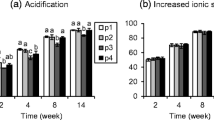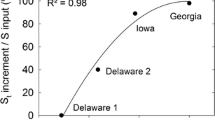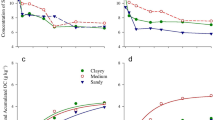Abstract
The effectiveness of elemental sulfur (S°) as a fertilizer is governed by its rate of microbial oxidation in soil to the sulfate form for absorption by plants. Some 80 field oxidation rate experiments were conducted under grazing throughout New Zealand for one year by measuring the residual S° in soil at approximately two-month intervals. The S° was applied as particles 75 to 150µm in diameter at the rate of 30 kg ha−1. The simple cubic oxidation rate model (no allowance for temperature or moisture changes) accounted for more than 80% of the variance at nearly 70% of sites.
The mean annual soil temperature (10-cm depth) was the most important factor found affecting the mean annual oxidation rate constants, accounting for 38% of the variance through the Arrhenius equation. Other factors, including rainfall, soil moisture, pH and soil groups accounted for only a further 2% of variance. The factor most likely to account for the balance of variance among the sites is the oxidizing efficiency of the associated microorganisms.
The rate constant versus temperature relationship for field oxidation in the five New Zealand climate regions was consistent with mean rate constants of soil groups from a similar set of 47 soils incubated at 25°C and field capacity moisture for 10 weeks or more. Field soils, therefore, had an average moisture for the oxidation rate equivalent to that at field capacity. This would explain the lack of contribution of soil moisture to the variance, and would support the use of the mean annual oxidation rate constant (from the mean annual soil temperature) for calculating the optimum particle size range of S° fertilizer. In confirmation, S° particle size recommendations from field rate constants for pastoral fertilizer were consistent with those from earlier agronomic experiments.
Similar content being viewed by others
References
Aldridge R and Cook FJ (1983) Estimation of soil temperatures at 0.1 m, and 0.3m depths. N Z Soil Bur Sci Rep 62: 18 p
Barrow NJ (1971)Slowly available fertilizers in southwestern Australia. 1. Elemental sulfur. Aust J Exp Agric Anim Husb 11: 211–216
Boswell CC (1992) Rate constants of oxidation of elemental sulphur in Otago and Southland. Invermay Technical Report No. 31: 66 p
Boswell CC and Swanney B (1986) Alternative sulphur fertilisers in New Zealand. Proc N Z Grassl Assoc 47: 233–242
Boswell CC and Swanney B (1988) The effects of particle size, rate and frequency of application of elemental sulphur on the release of sulphate to lucerne in the upper Waitaki basin. In: White RE and Currie LD (eds) Towards the more efficient use of soil and fertilizer sulphur, pp 159–168. Occasional Report No 2, Fertilizer and Lime Research Centre, Massey University, Palmerston North, New Zealand
Boswell CC, Thorrold BS, Watkinson JH, Lee A and Power IL (1992) Effect of soil temperature on the rate of oxidation of elemental sulphur. Proc N Z Grassl Assoc 54: 49–53
Chapman SJ (1989) Oxidation of micronized elemental sulphur in soil. Plant Soil 116: 69–76
Chatupote W, Moodie H, Hedley MJ, Bolan NS and Macgregor AN (1988) Effect of phosphate fertilizer form on the oxidation of elemental sulphur in soils. In: White RE and Currie LD (eds) Towards the more efficient use of soil and fertilizer sulphur, pp 179–192. Occasional Report No 2, Massey Fertilizer and Lime Research Centre, Massey University, Palmerston North, New Zealand
Germida JJ, Lawrence JR and Gupta VVSR (1984) Microbial oxidation of sulphur in Saskatchewan soils. Proc Int Sulphur 1984 Conf: 703–710
Ghani A, Lee A, Watkinson JH, Boswell CC, Thorrold BS, Morton JD and Upsdell MP (1993) The quantification of oxidation of elemental sulphur in pastoral soils of New Zealand. Proc XVII International Grassland Congress: (In press)
Janzen HH and Bettany JR (1987a) Measurement of sulfur oxidation in soils. Soil Sci 143: 444–452
Janzen HH and Bettany JR (1987b) The effect of temperature and water potential on sulfur oxidation in soils. Soil Sci 144: 81–89
Kittams HA and Attoe OJ (1965) Availability of phosphorus in rock phosphate-sulfur fusions. Agron J 57: 331–334
Lee A, Boswell CC and Watkinson JH (1988a) Effect of particle size on the oxidation of elemental sulphur, thiobacilli numbers, soil sulphate, and its availability to pasture. N Z J Agric Res 31: 179–186
Lee A, Watkinson JH, Orbell G, Bagyaraj J and Lauren DR (1987) Factors influencing dissolution of phosphate rock and oxidation of elemental sulphur in some New Zealand soils. N Z J Agric Res 30: 373–385
Lee A, Watkinson JH and Lauren DR (1988b) Factors affecting oxidation rates of elemental sulphur in a soil under a ryegrass dominant sward. Soil Biol Biochem 20: 809–816
McCaskill MR and Blair GJ (1989) A model for the release of sulfur from elemental S and superphosphate. Fert Res 19: 77–84
Meyer B (1977) Sulfur, Energy and the Environment. Elsevier, Amsterdam
Moser US and Olson RV (1953) Sulfur oxidation in four soils as influenced by soil moisture tension and sulfur bacteria. Soil Sci 76: 251–256
New Zealand Meteorological Service (1984a) Climate map series. Part 3a: 10-cm soil temperatures. New Zealand Meteorological Service miscellaneous publication 175
New Zealand Meteorological Service (1984b) Rainfall normals for New Zealand 1951–1980. New Zealand Meteorological Service miscellaneous publication 185
Radcliffe JE and Lefever KR (1981) Aspect influences on pasture microclimate at Coopers Creek, North Canterbury. N Z J Agric Res 24: 55–66
Sinclair AG and Boswell CC (1983) The agronomic properties of sulphur fertilisers. Proc New Zealand Fert Manufacturers' Res Assoc Conf 1: 377–389
Sinclair AG, Boswell CC, Cornforth IS, Lee A, Morgan C, Nguyen L, Saunders WMH, Shannon P, Smith RG and Whelan G (1985) Agronomic requirements for sulphur in New Zealand pastures. Proc New Zealand Fert Manufacturers' Res Assoc Conf 2: 538–572
Sinclair AG and Enright PD (1983) Effectiveness of elemental sulphur fertilisers. In: Gregg PEH and Syers JK (eds) Sulphur in New Zealand Agriculture, pp164–174. Occasional Report No 4, Dept Soil Sci, Massey University, Palmerston North, New Zealand
Solberg ED, Penney DC and Nyborg MN (1992) Factors affecting the effective use of elemental sulphur fertilizer in Western Canada. Proc Int Symp on the Role of Sulphur, Magnesium and Micronutrients in Balanced Plant Nutrition 1991: 222–233
Wainwright M (1984) Sulfur oxidation in soils. Adv Agron 37: 349–396
Watkinson JH (1989) Measurement of the oxidation rate of elemental sulfur in soil. Aust J Soil Res 27: 365–375
Watkinson JH (1993) Oxidation rate of elemental sulfur particles with a wide range of sizes. Aust J Soil Res 31: 67–72
Watkinson JH and Blair GJ (1993) Modelling the oxidation of elemental sulfur in soils. Fert Res: 35: 127–149
Watkinson JH and Lee A (1992) A mechanistic model for the oxidation rate of elemental sulphur in soil tested on results by HPLC. Proc Middle East Sulphur Symp Feb 1990: 163–171
Watkinson JH, Lee A and Lauren DR (1987) Measurement of elemental sulfur in soil and sediments: Field sampling, sample storage, pretreatment, extraction and analysis by high-performance liquid chromatography. Aust J Soil Res 25: 167–178
Author information
Authors and Affiliations
Rights and permissions
About this article
Cite this article
Watkinson, J.H., Lee, A. Kinetics of field oxidation of elemental sulfur in New Zealand pastoral soils and the effects of soil temperature and moisture. Fertilizer Research 37, 59–68 (1994). https://doi.org/10.1007/BF00750674
Received:
Accepted:
Issue Date:
DOI: https://doi.org/10.1007/BF00750674




